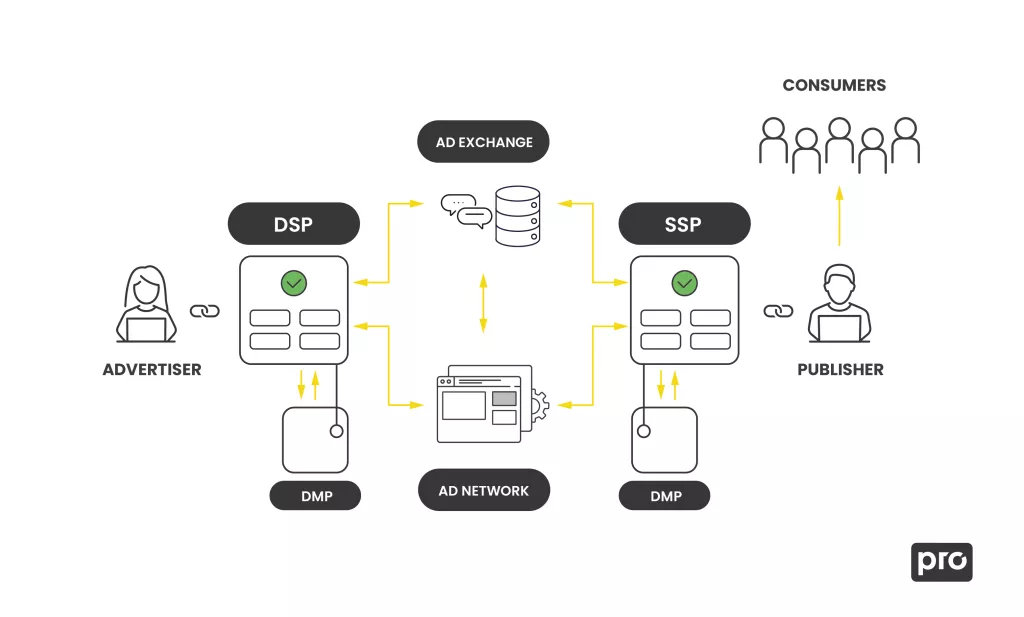DSP vs SSP are two important terms that are important in the world of digital advertising. These platforms play key roles in how online ads are bought and sold. But what exactly are they, and how do they work? Let’s break it down.
Definition of DSP

Demand-Side Platform (DSP) is software that helps advertisers buy digital ad space automatically. Instead of negotiating with individual websites, advertisers can use a DSP to purchase ad space from many sources at once.
Understanding DSP Functionality
Here’s a simple way to understand it:
- A user visits a website.
- Information about this user is collected and sent to the DSP.
- The DSP analyzes this data to find out if this user is a good match for the advertiser.
- The DSP then bids on the available ad space in real-time.
- If the bid wins, the ad is shown to the user.
Advantages of Using DSP
- Cost Savings: Since ads are bought through auctions, advertisers can often get ad space at a lower price.
- Efficiency: DSPs automate the ad-buying process, making it quicker and easier.
- Wide Reach: DSPs give access to a vast network of websites, meaning advertisers don’t have to negotiate with each one individually.
- Precise Targeting: DSPs use data to target ads more accurately, reaching the right audience at the right time.
- Detailed Reporting: Advertisers can track how their ads are performing and make adjustments as needed.
Definition of SSP
Supply-Side Platform(SSP) is software that publishers (like websites and apps) use to sell their available ad space. It helps them connect with multiple DSPs to maximize their ad revenue.
Understanding SSP Functionality
Here’s a simple explanation:
- A publisher has ad space available on their site.
- The SSP lists this space on an ad exchange or sends the details to DSPs.
- DSPs bid on the ad space in real-time.
- The highest bid wins, and the ad is shown on the publisher’s site.
Advantages of Using SSP
- Automated Sales: SSPs handle the selling process, making it more efficient.
- Access to More Buyers: SSPs connect with multiple ad networks and DSPs, increasing the chances of selling ad space.
- Better Inventory Management: Publishers can control who buys their ad space and at what price.
- Price Control: SSPs allow publishers to set a minimum price for their ad space.
- Frequency Capping: SSPs can limit how often the same ad is shown to users, preventing them from seeing the same ad too often.
DSP vs SSP: What’s the Difference?
- DSP (Demand-Side Platform): Used by advertisers to buy ad space.
- SSP (Supply-Side Platform): Used by publishers to sell ad space.
In simple terms, DSPs are for buying ads, and SSPs are for selling ads. They work together to match the right ads with the right audiences at the best prices.
How DSPs and SSPs Collaborate in Google Ads Exchange
Let’s break down how DSP vs SSP work together in the Google Ad Exchange, especially during a programmatic ad auction.
Imagine lentia.id, a website that wants to fill its Video Pre-roll ad spots with ads that pay an average of $7-8 per thousand views (eCPM). Several advertisers want to show their video ads, and their DSPs are connected to the same ad exchange as lentia.id’s SSP.
Here’s how it all happens:
- User Visits the Site: A user goes to lentia.id and starts watching a video. This triggers a request for a Video Pre-roll ad. lentia.id sends this request to its SSP, which checks the available ad space and the user’s profile.
- SSP Confirms Ad Availability: The SSP confirms that a Video Pre-roll ad can be shown to this user.
- Ad Exchange Notifies DSPs: The ad exchange shares this information with DSPs that are interested in placing Video Pre-roll ads.
- DSPs Place Bids: DSPs evaluate the user data, such as their demographics and online behavior, and place bids to show their ads. Bids might come in at $7.50, $8.00, and $7.80.
- Highest Bid Wins: The ad exchange identifies the highest bid, which in this case is $8.00, and declares it the winner.
- Ad is Displayed: The winning video ad is then shown to the user on lentia.id before the main content begins. This way, the DSP, SSP, and ad exchange work together to ensure the best results for both the advertiser and the publisher.
ProPS can help publishers maximize their ad space using DSP vs SSP like Google Ad Exchange. We can help you manage your ad inventory, optimize your bidding, and ensure you’re getting the best return on your ads. Whether you’re new to programmatic advertising or looking to improve your strategy, ProPS is here to support you.
